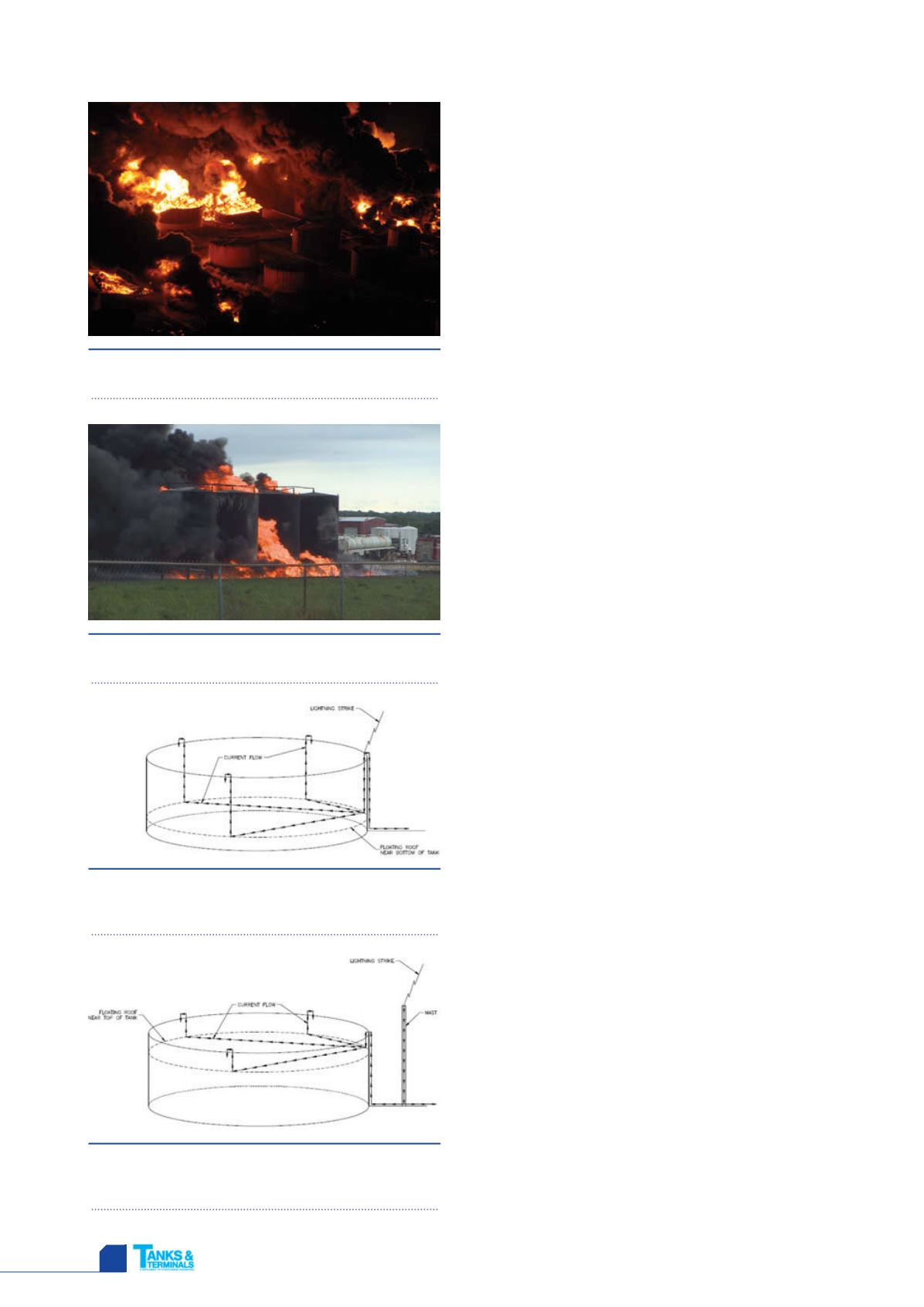
HYDROCARBON
ENGINEERING
62
combustible vapour and ground could occur, as illustrated in
Figure 6. A direct or nearby lightning strike will cause a rise of
ground potential, and of all grounded objects, by hundreds of
thousands of volts in a fewmilliseconds. If the potential
difference between a grounded object or surface is exposed to
the vapour and the vapour reaches the electrical breakdown
strength of the vapour space, an arc will form and ignition will
follow.
FRT recommended practices
Historically for FRTs, shunts were used to ‘bond’ the floating
roof to the shell of the tank. A shunt is a strip of string steel,
affixed to the floating roof and sliding against the inside tank
wall. Unfortunately, shunts do not provide a positive, low
impedance bond between the floating roof and tank shell for
several reasons, including:
n
Heavy crude oil components, such as wax and tar, can
accumulate on the inside of the tank wall, thus increasing
contact resistance.
n
Corrosion (rust) on the inside of the shell will increase the
resistance of the bond between the shell and shunts.
n
Many FRTs are painted on the inside, typically with an
epoxy-based paint. If the inside of the tank is painted, the
paint will insulate the shell from the shunts.
n
Large tanks are typically out-of-round by several inches. If a
tank is elongated for some reason, the shunts will be pulled
away from the shell in the long dimension of the tank.
Independent third party testing, performed in cooperation
with the API and the Energy Institute in the UK, has shown that
arcing will occur at the shunt-shell interface under all
conditions; it does not matter if the shunts are clean or dirty,
new or old, neglected or well maintained. It also does not
matter if the inner shell walls are clean, rusty, painted or coated;
arcing will occur in all situations. This testing programme has
been well documented in API 545-A.
API RP 545 is the ‘Recommended Practice for Lightning
Protection of Aboveground Storage Tanks for Flammable or
Combustible Liquids’. NFPA 780 is the ‘Standard for the
Installation of Lightning Protection Systems’. Both standards
recommend installing multiple roof-to-shell bypass conductors
on floating roof storage tanks. During a lightning event,
Component C of the strike will be conducted by the bypass
conductors, thus preventing sustained arcing at the seal
interface (it is Component C that causes ignition). The bypass
conductors will ensure that the roof and shell stay at the same
potential during thunderstorms, thus mitigating the risk of
ignition of flammable vapours that may be present. There are
thousands of floating roof storage tanks currently in operation,
with the majority of them lacking sufficient bypass conductors,
thus increasing their risk of lightning-related fires.
Non-metal production tank
recommended practices
NFPA 77 is the ‘Recommended Practice on Static Electricity’.
API RP 2003 is the ‘Recommended Practice for Protection
Against Ignitions Arising Out of Static, Lightning, and Stray
Currents’. Both NFPA 77 and API 2003 recommend an internal
grounding conductor inside all non-conductive and lined tanks
being used to store a potentially combustible fluid. This internal
grounding conductor must be grounded to earth to effectively
Figure 1.
Lightning-related tank fire on internal
FRT – Caribbean Petroleum, Puerto Rico, 2009.
Figure 2.
Lightning-related fire at injection well
facility, Deanville, Texas, 2015.
Figure 3.
Illustration of current flows resulting from
lightning strike to tank shell (note that current flows
across the roof-shell interface in numerous locations).
Figure 4.
Illustration of current flows resulting from
nearby lightning strike (note that current flows across
the roof-shell interface in multiple locations).


